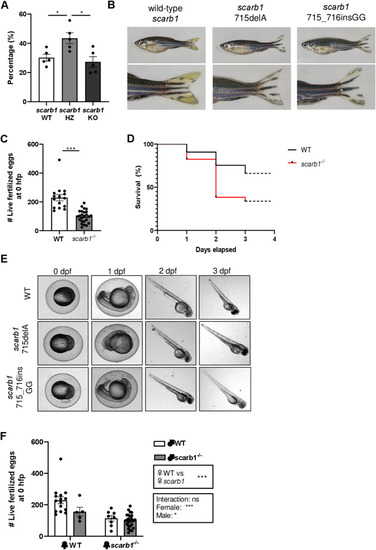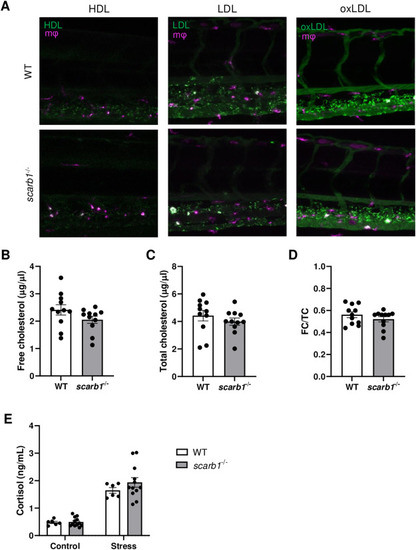- Title
-
Zebrafish as outgroup model to study evolution of scavenger receptor class B type I functions
- Authors
- Verwilligen, R.A.F., Mulder, L., Araújo, P.M., Carneiro, M., Bussmann, J., Hoekstra, M., Van Eck, M.
- Source
- Full text @ BBA Molecular and Cell Biology of Lipids
|
Fig. 1. SCARB1 deficiency in zebrafish is linked to reduced fertility. (A) Percentage of zebrafish that are WT, heterozygous (HZ) or knock-out (KO)(of total laid eggs) after crossing scarb1+/− fish (n = 5 individual scarb1+/− crossings). (B) Representative pictures of adult females and their tails (scarb1 715delA and scarb1 715_716insGG homozygous and sibling controls) at 3 months post-fertilization. (C) Total fertilized egg count at 0 h post fertilization (hpf) produced by WT or scarb1−/− breeding pairs (nWT = 15 breeding pairs, n-1nt = 16 breeding pairs, n+2nt = 9 breeding pairs). (D) Percentage of survival from 0 hpf till 3 days post fertilization (dpf) of WT and scarb1−/− zebrafish larvae. (E) Representative picture of the development of scarb1−/− embryo's compared to WT embryo's at 0 till 3 dpf. (F) Total fertilized egg count at 0 h post fertilization (hpf) produced by outcrosses (♀ WT × ♂ WT (n = 15 breeding pairs), ♀ WT × ♂ scarb1−/− (n = 5 breeding pairs), ♀ scarb1−/− × ♂ WT (n = 8 breeding pairs), ♀ scarb1−/− × ♂ scarb1−/− (n = 25 breeding pairs)). Means ± SEM; p < 0.05*, p < 0.001*** (One-way ANOVA (multiple groups) or Student's t-test). |
|
Fig. 2. Deficiency of SCARB1 affects uptake of HDL in the liver (A) Injection of DiO-HDL (3 h post injection)(green) in 3dpf WT and scarb1−/− zebrafish larvae. Magnification 10× (B) Uptake and (C) quantification of DiO-HDL in livers of 3dpf WT (nWT = 3) and scarb1−/− larvae (n-1nt = 3 and n+2nt = 3). Quantification was performed by manually counting the HDL uptake (punctae) outside the sinusoids of 3 confocal image depths per zebrafish. Means ± SEM. p < 0.001*** (Student's t-test). (For interpretation of the references to colour in this figure legend, the reader is referred to the web version of this article.) PHENOTYPE:
|
|
Fig. 3. Deficiency of SCARB1 does not alter fluorescently-labeled lipoprotein uptake in the caudal vein, total plasma cholesterol, and stress-induced cortisol levels in zebrafish (A) Uptake of DiO-HDL (24 h post injection)(green), Bodipy-LDL and DiO-oxLDL (30-60 min post injection)(green) by macrophages (purple) in WT and scarb1−/− zebrafish larvae. Magnification 40× (B) Free serum cholesterol (FC) (C) total serum cholesterol levels (TC) and (D) FC/TC ratio of WT sibling (nWT = 11 pooled samples of 2) and homozygous scarb1−/− zebrafish (n-1nt = 5 and n+2nt = 6 pooled samples of 2) measured with enzymatic colorimetric assay. (E) Cortisol levels of WT (nWT = 6 pooled samples of 30) and scarb1−/− zebrafish larvae (n-1nt = 6 pooled samples of 30, n+2nt = 6 pooled samples of 30) at baseline and after net stress. (For interpretation of the references to colour in this figure legend, the reader is referred to the web version of this article.) |
|
Fig. 4. Colour and cholesterol levels in SCARB1 mutant canaries (A) Representative pictures of WT and SCARB1 mutant canaries. (B) Free and total cholesterol levels of WT or SCARB1 mutant canaries (n = 12 per genotype) (C) Schematic overview of the suggested functions of SCARB1 and its evolution (D) Overview of known functions in SCARB1 mutant vertebrates. Means ± SEM. p < 0.01**; p < 0.001*** (Student's t-test). |
|
of SCARB1 (A) Alignments of SCARB1 sequences were generated using the Clustal Omega alignment program (EMBL-EBI). Three known human SCARB1 mutation locations (rs397514572 [p.Ser112Phe], rs187831231 [p.Thr175Ala], rs387906791 [p.Pro297Ser]) as well as the Arg-174 and Asp-185 are highlighted in magenta. The amino acids that differ in only in zebrafish are highlighted in green. An asterisk (*) indicates positions which have a fully conserved residue. A colon (:) indicates conservation between sequences that have strong similar properties. A period (.) indicates conservation between sequences that have weak similar properties. (For interpretation of the references to colour in this figure legend, the reader is referred to the web version of this article.) |
Reprinted from Biochimica et biophysica acta. Molecular and cell biology of lipids, 1868(6), Verwilligen, R.A.F., Mulder, L., Araújo, P.M., Carneiro, M., Bussmann, J., Hoekstra, M., Van Eck, M., Zebrafish as outgroup model to study evolution of scavenger receptor class B type I functions, 159308, Copyright (2023) with permission from Elsevier. Full text @ BBA Molecular and Cell Biology of Lipids





